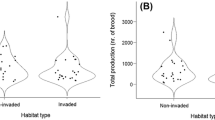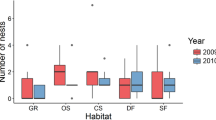Abstract
Ant-gardens are a mutualistic association involving epiphyte plants and one or several ant species. Ant-gardens inhabited by Camponotus femoratus (Fabricius, 1804) and Crematogaster levior (Longino, 2003), are the most commonly found in the Neotropical Region. These two ant species share the nest and their foraging trails but keep their brood separated (i.e., parabiosis). The larger Ca. femoratus defends the nest, while benefits from the foraging ability of C. levior. However, it is still not experimentally proven which of the two parabiotic species initiates nest building. Moreover, the growth dynamic of population for these two ant species is unknown. To address these topics, we analyzed the change in proportion of individuals from the two species depending on the nest volume. Our results show that (1) the proportion of Ca. femoratus workers increased with nest volume leading to a numerically domination of Ca. femoratus in the largest nests and (2) C. levior workers are likely to initiate the nest construction given that it represents the overwhelming majority of the small nests. These results reinforce the knowledge of the complex and understudied interaction between these two ant species. Ant-gardens arise as a mutualistic association between ants and epiphyte plants. Plants benefit from the dispersal of their seeds and defense by the patrolling ants, while provide nest structure to the ants. The ants Crematogaster levior and Camponotus femoratus live within common Ant-gardens. We studied the growth dynamic of the two species population with the volume of the Ant-garden nest. The proportion of Ca. femoratus increases with the nest volume resulting in a domination of the latter species on C. levior in the largest nets. Furthermore, our results, combined with field observations, suggest that C. levior can initiate the nest construction. These findings precise the complex relationship between the two ant species.

Similar content being viewed by others
Availability of data and material
The authors confirm that the data supporting the findings of this study are available within the article and its supplementary materials.
References
Blütghen N, Schmit-Neuerburg V, Engwald S, Barth-Lott W (2001) Ants as epiphyte gardeners: comparing the nutrient quality of ant and termite canopy substrates in a Venezuelan lowland rain forest. J Trop Ecol 17:887–894
Boomsma JJ, Grafen A (1990) Intraspecific variation in ant sex ratios and the Trivers-Hare hypothesis. Evolution 44:1026–1034
Bourke AFG, Franks NR (1995) Social evolution in ants. Princeton University Press, Princeton
Davidson DW (1988) Ecological studies of neotropical ant gardens. Ecology 69:1138–1152
Dejean A, Corbara B, Orivel J, Snelling RR, Delabie JHC, Belin-Depoux M (2000) The importance of ant gardens in the pioneer vegetal formations of French Guiana. Sociobiology 35:425–439
Hölldobler B, Wilson EO (1990) The ants. Harvard University Press, Cambridge
Kaufmann E (2002) Southeast Asian ant-gardens: diversity, ecol-ogy, ecosystematic significance, and evolution of mutualistic ant-epiphyte associations—PhD Thesis, Johann Wolfgang Goethe University
Leal LC, Jakovac CC, Borowiec PED, Camargo JLC, Peixoto PEC (2017) The role of parabiotic ants and environment on epiphyte composition and protection in ant gardens. Sociobiology 64:276–283
Longino JT (2003) The Crematogaster (Hymenoptera, Formicidae, Myrmicinae) of Costa Rica. Zootaxa 151:1–150
Macedo M, Prance GT (1978) Notes on the vegetation of Amazonia II. The dispersal of plants in Amazonian white sand campinas: the campinas as functional islands. Brittonia 30:203–215
Menzel F, Kriesell H, Witte V (2014) Parabiotic ants; the costs and benefits of symbiosis. Ecol Entomol. https://doi.org/10.1111/een.12116
Orivel J, Leroy C (2011) The diversity and ecology of ant gardens (Hymenoptera: Fromicidae; Spermatophyta: Angiospermae). Myrmecol News 14:73–85
Paolucci NL, Ricardo RCS, Leal CL (2016) Proximity shapes similarity in epiphytic composition of Neotropical ant gardens. J Trop Ecol. https://doi.org/10.1017/S0266467416000298
R Core Team (2019) R: a language and environment for statistical computing. R Foundation for Statistical Computing, Vienna, Austria
Schmit-Neuerburg V, Blütghen N (2007) Ant-garden epiphytes are protected against drought in a venezuelan lowland rainforest. Ecotropica 13:93–100
Swain RB (1977) The natural history of Monacis, a genus of neotropical ants (Hymenoptera: Formicidae). Dissertation. Harvard University
Swain RB (1980) Trophic competition among parabiotic ants. Insectes Soc 27:377–390
Ule E (1901) Ameisengärten in amazonasgebiet. Bot Jahrb Syst 30:45–52
Vantaux A, Dejean A, Dor A, Orivel J (2007) Parasitism versus mutualism in the ant-garden parabiosis between Camponotus femoratus and Crematogaster levior. Insectes Soc 54:95–99
Vicente RE, Dáttilo W, Izzo TJ (2014) Differential recruitment of Camponotus femoratus (Fabricius) ants in response to ant garden herbivory. Neotrop Entomol 43:519–525
Vicente RE, Izzo TJ (2017) Defining habitat use by the parabiotic ants Camponotus femoratus (Fabricius, 1804) and Crematogaster levior Longino, 2003. Sociobiology 64:373–380
Wickham H (2009) Elegant graphics for data. Springer, New York
Wilson EO (1987) The arboreal ant fauna of Peruvian Amazon forests: a first assessment. Biotropica 19:245–251
Youngsteadt E, Baca JA, Osborne J, Schal C (2009) Species-specific seed dispersal in an obligate ant-plant mutualism. PLoS ONE 2009:4. https://doi.org/10.1371/journal.pone.0004335)
Youngsteadt E, Bustios PG, Schal C (2010) Divergent chemical cues elicit seed collecting by ants in an obligate multi-species mutualism in lowland Amazonia. PLoS ONE 2010:5. https://doi.org/10.1371/journal.pone.0015822
Yu DW (1994) The structural role of epiphytes in ant gardens. Biotropica 26:222–226
Acknowledgements
Authors thank Ivone Vieira da Silva, Mendelson Guerreiro de Lima and Vinicius Morais for support and Willian Schornobay Bochenski, Gabriela Mendes, Jaidle Evangelista do Vale, Luiz Fernando Scatola, Igor Pereira do Nascimento, Andréia Anjo Pereira, Leandro Fagner da Silva and João Paulo Schmitt for your patience and incredible help. Furthermore, we thank Universidade do Estado de Mato Grosso (UNEMAT), ONF-Brasil and Fazenda São Nicolau for the logistic support, in special to Estelle, Alan, Laide, Gilberto and Suzana. Finally, we are grateful to Serge Aron, Didier Degueldre, Thiago Izzo and two anonymous reviewers for their useful comments.
Funding
This study was funded by Fundação de Amparo à Pesquisa do Estado de Mato Grosso (FAPEMAT—nº 0602346/2017) and Conselho Nacional de Desenvolvimento Científico e Tecnológico (CNPq—nº 313839/2019-0).
Author information
Authors and Affiliations
Contributions
PD, FD and REV designed the research, carried out the field collection, performed the research, analysed the data and wrote the paper.
Corresponding author
Ethics declarations
Conflicts of interest
The authors declare that they have no conflict of interest.
Supplementary Information
Below is the link to the electronic supplementary material.
40_2020_798_MOESM1_ESM.docx
Table S1: Latitude, longitude, collection date, volume and number of queens, males and workers of the two ant species for each nest (DOCX 16 KB)
Rights and permissions
About this article
Cite this article
Dacquin, P., Degueldre, F. & Vicente, R.E. Relative colony size of parabiotic species demonstrates inversion with growth. Insect. Soc. 68, 77–80 (2021). https://doi.org/10.1007/s00040-020-00798-x
Received:
Revised:
Accepted:
Published:
Issue Date:
DOI: https://doi.org/10.1007/s00040-020-00798-x




